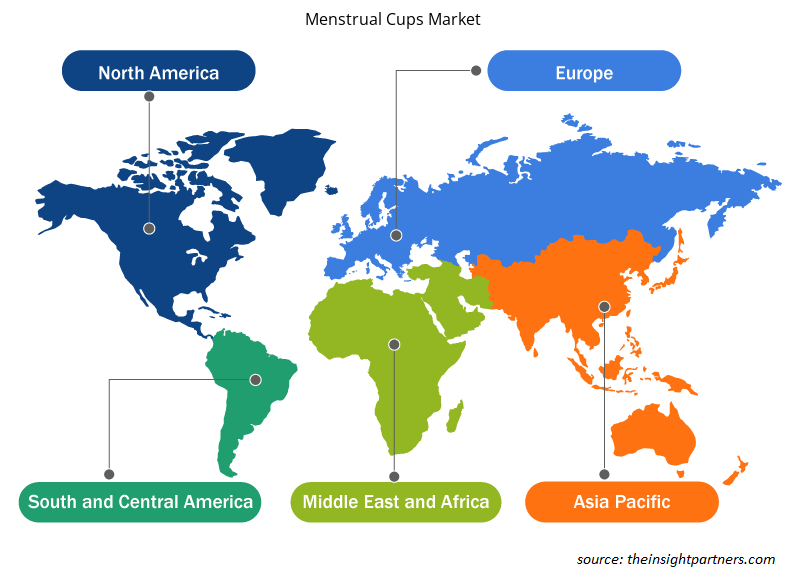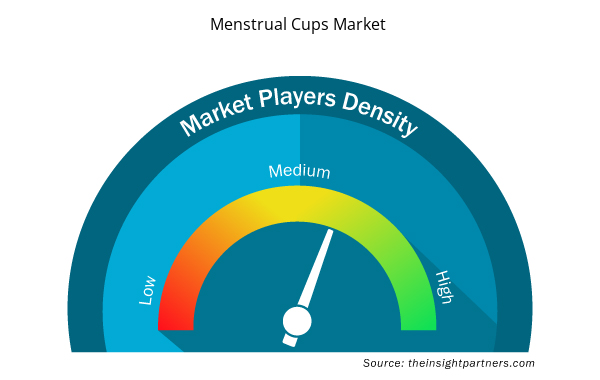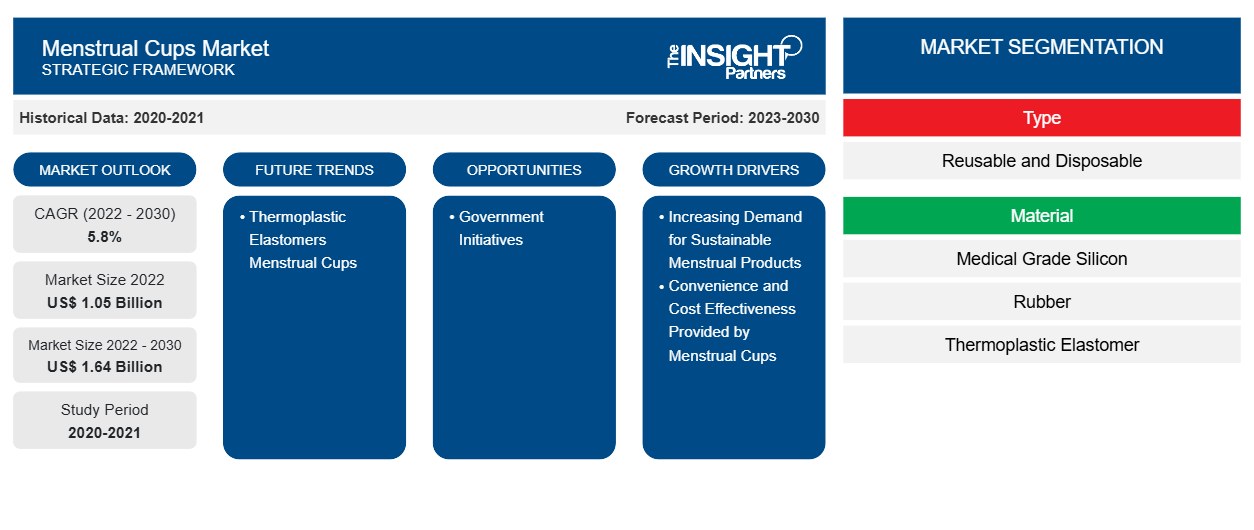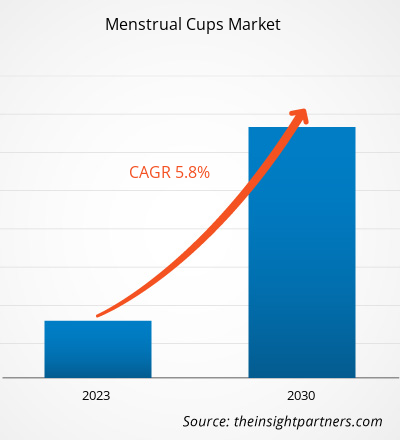[تقرير بحثي] تم تقييم حجم سوق أكواب الدورة الشهرية بـ 1،050.81 مليون دولار أمريكي في عام 2022 ومن المتوقع أن يصل إلى 1،644.06 مليون دولار أمريكي بحلول عام 2030؛ ومن المتوقع أن يسجل معدل نمو سنوي مركب بنسبة 5.8٪ من عام 2022 إلى عام 2030.
رؤى السوق ووجهة نظر المحلل:
أكواب الدورة الشهرية هي أجهزة على شكل جرس قابلة لإعادة الاستخدام ومصممة للنظافة النسائية أثناء الدورة الشهرية. وعادة ما تكون مصنوعة من السيليكون أو المطاط الطبي، ويتم إدخال هذه الأكواب في المهبل لجمع سائل الدورة الشهرية بدلاً من امتصاصه مثل السدادات القطنية أو الفوط الصحية التقليدية. وهي تخلق ختمًا لمنع التسرب ويمكن ارتداؤها لمدة تصل إلى 12 ساعة قبل الحاجة إلى إفراغها، مما يوفر بديلاً مستدامًا وفعّالاً من حيث التكلفة للمنتجات التي تُستعمل لمرة واحدة. تكتسب أكواب الدورة الشهرية شعبية كبيرة بسبب فوائدها البيئية وتوفير التكاليف على المدى الطويل مقارنة بخيارات النظافة الشهرية التقليدية.
محركات النمو والتحديات:
الطلب المتزايد على منتجات الدورة الشهرية المستدامة هو المحرك الأساسي لسوق أكواب الدورة الشهرية. في السنوات الأخيرة، كان هناك تحول عالمي نحو الاستدامة، حيث أصبح المستهلكون على دراية متزايدة بالتأثير البيئي لمنتجات الدورة الشهرية التقليدية التي تُستعمل لمرة واحدة. تساهم الفوط الصحية والسدادات القطنية التقليدية بشكل كبير في النفايات البلاستيكية، ويتضمن إنتاجها استهلاك الموارد والطاقة. في كل عام، تتخلص المرأة المتوسطة من حوالي 150 كيلوغرامًا من النفايات غير القابلة للتحلل البيولوجي. في الهند وحدها، تستخدم حوالي 121 مليون امرأة وفتاة ما معدله ثماني فوطة صحية تُستعمل لمرة واحدة وغير قابلة للتحلل شهريًا، مما ينتج عنه 1.021 مليار فوطة نفايات شهريًا، و12.3 مليار فوطة نفايات سنويًا، و113000 طن متري من النفايات الشهرية السنوية. ظهرت أكواب الدورة الشهرية كخيار رائد حيث يبحث الأفراد عن بدائل صديقة للبيئة بسبب طبيعتها القابلة لإعادة الاستخدام. يدفع هذا الوعي البيئي المتزايد المستهلكين إلى اختيار المنتجات التي تقلل من بصمتهم البيئية، مما يعزز الطلب على أكواب الدورة الشهرية.
يرتبط الطلب المتزايد على منتجات الدورة الشهرية المستدامة ارتباطًا وثيقًا بحركة أوسع نطاقًا تدافع عن صحة المرأة ورفاهتها. ويعطي المستهلكون الأولوية بشكل متزايد للمنتجات التي لا تفيد البيئة فحسب، بل وأيضًا آمنة ومفيدة لصحتهم. وتعتبر أكواب الدورة الشهرية، المصنوعة عادةً من السيليكون الطبي أو المطاط أو الإيلاستومرات الحرارية البلاستيكية، آمنة وصحية، مما يقلل من خطر التهيج وردود الفعل التحسسية المرتبطة غالبًا بالمنتجات التقليدية. يساهم توافق أكواب الدورة الشهرية مع الاستدامة البيئية وصحة المرأة في جاذبيتها، ويعمل كمحرك لشعبيتها المتزايدة.
قم بتخصيص هذا التقرير ليناسب متطلباتك
ستحصل على تخصيص لأي تقرير - مجانًا - بما في ذلك أجزاء من هذا التقرير، أو تحليل على مستوى الدولة، وحزمة بيانات Excel، بالإضافة إلى الاستفادة من العروض والخصومات الرائعة للشركات الناشئة والجامعات
- احصل على أهم اتجاهات السوق الرئيسية لهذا التقرير.ستتضمن هذه العينة المجانية تحليلاً للبيانات، بدءًا من اتجاهات السوق وحتى التقديرات والتوقعات.
وقد تزايدت الدعوة إلى الاستدامة في منتجات الدورة الشهرية من خلال العديد من جماعات المناصرة والمنظمات غير الحكومية والمبادرات الحكومية التي تهدف إلى زيادة الوعي بالتأثير البيئي للخيارات التي يمكن التخلص منها. وكانت الحملات التي تروج للدورة الشهرية المستدامة حاسمة في تثقيف الجمهور حول فوائد البدائل القابلة لإعادة الاستخدام مثل أكواب الدورة الشهرية. ويساهم تزايد وضوح ودعم ممارسات الدورة الشهرية المستدامة في إحداث تحول إيجابي في مواقف المستهلكين، مما يعزز قبول وتبني أكواب الدورة الشهرية.
كما أن الطلب على منتجات الدورة الشهرية المستدامة مدفوع أيضًا بجيل أصغر سنًا من المستهلكين الذين يعطون الأولوية للاختيارات الصديقة للبيئة. ويقود جيل الألفية والجيل Z، على وجه الخصوص، الطلب على المنتجات المستدامة والأخلاقية في مختلف الصناعات، بما في ذلك العناية الشخصية. وتؤثر وعي وتفضيلات هذه التركيبة السكانية على اتجاهات السوق، وتتوافق أكواب الدورة الشهرية، باعتبارها خيارًا مستدامًا وتقدميًا، بشكل جيد مع قيمهم. ومع استمرار نمو هذه التركيبة السكانية في القوة الشرائية، سينمو الطلب على أكواب الدورة الشهرية أيضًا، مما يعزز مكانتها في السوق كمنتج رائد مستدام للدورة الشهرية.
ومع ذلك، فإن إدراك المستهلك وجهله يمثلان قيودًا كبيرة في سوق أكواب الدورة الشهرية، مما يؤثر على معدلات التبني على مستوى العالم. يظل العديد من الأفراد غير مطلعين على فوائد أكواب الدورة الشهرية بسبب الافتقار إلى حملات التعليم والتوعية الشاملة. إن عدم الإلمام بالمنتج ومزاياه، مثل الفعالية من حيث التكلفة، وتقليل التأثير البيئي، وإطالة فترة الارتداء، يساهم في إحجام المستخدمين المحتملين عن التحول من منتجات الدورة الشهرية التقليدية. يمكن أن يؤدي هذا الافتقار إلى المعرفة إلى مفاهيم خاطئة وتثبيط، مما يعيق القبول الأوسع لكؤوس الدورة الشهرية كبديل قابل للتطبيق وعملي.
إن التردد في استخدام أكواب الدورة الشهرية يرجع في كثير من الأحيان إلى مخاوف بشأن صعوبة إدخالها وإخراجها. ويرى العديد من المستهلكين أن منحنى التعلم المرتبط باستخدام أكواب الدورة الشهرية يشكل حاجزًا، على افتراض أنه يتطلب مستوى من المهارة أو الراحة قد لا يتمتعون به. ويساهم الافتقار إلى الفهم حول الاستخدام المباشر لأكواب الدورة الشهرية والفوائد الصحية المحتملة في هذا التخوف. ويتطلب التغلب على هذه الأفكار المسبقة والمفاهيم الخاطئة جهودًا تعليمية مستهدفة لتسليط الضوء على سهولة استخدام أكواب الدورة الشهرية وراحتها وتأثيرها البيئي الإيجابي. ومن خلال معالجة هذه المخاوف وتعزيز الوعي، يمكن للسوق أن يعمل على تبديد الأساطير وتشجيع تصور أكثر إيجابية لكؤوس الدورة الشهرية بين المستخدمات المحتملات.
تقسيم التقرير ونطاقه:
يتم تقسيم سوق أكواب الدورة الشهرية العالمية على أساس النوع والمادة وقناة التوزيع والجغرافيا. بناءً على النوع، يتم تصنيف السوق إلى قابلة لإعادة الاستخدام وقابلة للتخلص منها. حسب المادة، يتم تصنيف السوق إلى السيليكون الطبي والمطاط والإيلاستومر الحراري. حسب قناة التوزيع، يتم تصنيف السوق إلى محلات السوبر ماركت والهايبر ماركت والمتاجر المتخصصة وتجارة التجزئة عبر الإنترنت وغيرها. حسب الجغرافيا، يتم تقسيم سوق أكواب الدورة الشهرية العالمية على نطاق واسع إلى أمريكا الشمالية وأوروبا ومنطقة آسيا والمحيط الهادئ والشرق الأوسط وأفريقيا وأمريكا الجنوبية والوسطى.
التحليل القطاعي:
بناءً على النوع، يتم تصنيف سوق أكواب الدورة الشهرية إلى قابلة لإعادة الاستخدام وقابلة للاستخدام مرة واحدة. ومن المتوقع أن يسجل قطاع القابل لإعادة الاستخدام أعلى معدل نمو سنوي مركب خلال الفترة 2022-2030. تمثل أكواب الدورة الشهرية القابلة لإعادة الاستخدام ثورة مستدامة وفعالة من حيث التكلفة في نظافة الدورة الشهرية. عادةً ما يتم تصنيع هذه الأكواب على شكل جرس من السيليكون الطبي أو المطاط أو الإيلاستومرات الحرارية، ويتم إدخالها في المهبل لجمع تدفق الدورة الشهرية بدلاً من امتصاصه مثل السدادات القطنية أو الفوط الصحية التقليدية. تضمن مرونة ونعومة المادة الراحة وسهولة الاستخدام، والتكيف مع تشريح المستخدم. يمكن ارتداء أكواب الدورة الشهرية القابلة لإعادة الاستخدام لمدة تصل إلى 12 ساعة، مما يوفر حماية خالية من التسرب ويسمح للمستخدمين بمرونة أكبر في إدارة فتراتهم. تتمثل إحدى أهم مزاياها في تأثيرها البيئي، حيث يمكن إعادة استخدامها. تقلل الأكواب بشكل كبير من كمية النفايات الشهرية الناتجة، مما يساهم في روتين رعاية الدورة الشهرية الصديق للبيئة. بالإضافة إلى ذلك، فإن توفير التكاليف على المدى الطويل والراحة المتمثلة في عدم الحاجة إلى شراء المنتجات التي تستخدم لمرة واحدة بانتظام تجعل من أكواب الدورة الشهرية القابلة لإعادة الاستخدام خيارًا شائعًا بشكل متزايد للمستخدمين الذين يبحثون عن بدائل مستدامة وعملية في نظافة الدورة الشهرية.
التحليل الإقليمي:
تم تقسيم سوق أكواب الدورة الشهرية إلى خمس مناطق رئيسية: أمريكا الشمالية وأوروبا وآسيا والمحيط الهادئ وأمريكا الجنوبية والوسطى والشرق الأوسط وأفريقيا. سيطرت أمريكا الشمالية على سوق أكواب الدورة الشهرية العالمية في عام 2022، حيث بلغت قيمة السوق في هذه المنطقة 395.41 مليون دولار أمريكي. تعد أوروبا ثاني أكبر مساهم، حيث تمتلك أكثر من 30٪ من حصة السوق العالمية. ومن المتوقع أن تسجل منطقة آسيا والمحيط الهادئ معدل نمو سنوي مركب كبير يتجاوز 5٪ خلال الفترة 2022-2030. يمكن أن يُعزى الارتفاع في الطلب على أكواب الدورة الشهرية في منطقة آسيا والمحيط الهادئ إلى عوامل مختلفة، بما في ذلك التحولات الثقافية المتزايدة، وزيادة الوعي، والأهمية المتزايدة لصحة المرأة. كانت هناك حركة متزايدة نحو كسر المحرمات المحيطة بالحيض في العديد من البلدان الآسيوية.
تأثير جائحة كوفيد-19:
أعاقت جائحة كوفيد-19 في البداية سوق أكواب الدورة الشهرية العالمية بسبب إغلاق وحدات التصنيع ونقص العمالة وتعطل سلاسل التوريد وعدم الاستقرار المالي. أدى تعطيل العمليات في مختلف الصناعات بسبب التباطؤ الاقتصادي الناجم عن تفشي كوفيد-19 إلى تقييد إمدادات أكواب الدورة الشهرية. علاوة على ذلك، تم إغلاق العديد من المتاجر، مما حد من مبيعات أكواب الدورة الشهرية. ومع ذلك، بدأت الشركات في اكتساب أرضية حيث تم إلغاء القيود المفروضة سابقًا في مختلف البلدان في عام 2021. علاوة على ذلك، أدى تنفيذ حملات التطعيم ضد كوفيد-19 من قبل حكومات بلدان مختلفة إلى تخفيف الوضع، مما أدى إلى زيادة الأنشطة التجارية في جميع أنحاء العالم. أفادت العديد من الأسواق، بما في ذلك سوق أكواب الدورة الشهرية، عن نمو بعد تخفيف عمليات الإغلاق والقيود المفروضة على الحركة.
نظرة إقليمية على سوق أكواب الدورة الشهرية
لقد قام المحللون في Insight Partners بشرح الاتجاهات والعوامل الإقليمية المؤثرة على سوق أكواب الدورة الشهرية طوال فترة التوقعات بشكل شامل. يناقش هذا القسم أيضًا قطاعات سوق أكواب الدورة الشهرية والجغرافيا في جميع أنحاء أمريكا الشمالية وأوروبا ومنطقة آسيا والمحيط الهادئ والشرق الأوسط وأفريقيا وأمريكا الجنوبية والوسطى.

- احصل على البيانات الإقليمية المحددة لسوق أكواب الدورة الشهرية
نطاق تقرير سوق أكواب الدورة الشهرية
| سمة التقرير | تفاصيل |
|---|---|
| حجم السوق في عام 2022 | 1.05 مليار دولار أمريكي |
| حجم السوق بحلول عام 2030 | 1.64 مليار دولار أمريكي |
| معدل النمو السنوي المركب العالمي (2022 - 2030) | 5.8% |
| البيانات التاريخية | 2020-2021 |
| فترة التنبؤ | 2023-2030 |
| القطاعات المغطاة | حسب النوع
|
| المناطق والدول المغطاة | أمريكا الشمالية
|
| قادة السوق وملفات تعريف الشركات الرئيسية |
|
كثافة اللاعبين في سوق أكواب الدورة الشهرية: فهم تأثيرها على ديناميكيات الأعمال
يشهد سوق أكواب الدورة الشهرية نموًا سريعًا، مدفوعًا بالطلب المتزايد من المستخدم النهائي بسبب عوامل مثل تفضيلات المستهلكين المتطورة والتقدم التكنولوجي والوعي المتزايد بفوائد المنتج. ومع ارتفاع الطلب، تعمل الشركات على توسيع عروضها والابتكار لتلبية احتياجات المستهلكين والاستفادة من الاتجاهات الناشئة، مما يؤدي إلى زيادة نمو السوق.
تشير كثافة اللاعبين في السوق إلى توزيع الشركات أو المؤسسات العاملة في سوق أو صناعة معينة. وهي تشير إلى عدد المنافسين (اللاعبين في السوق) الموجودين في مساحة سوق معينة نسبة إلى حجمها أو قيمتها السوقية الإجمالية.
الشركات الرئيسية العاملة في سوق كؤوس الدورة الشهرية هي:
- نيكسيت
- لونيت جلوبال
- لينا كاب ذ.م.م
- شركة ديفا الدولية
- سالت
إخلاء المسؤولية : الشركات المذكورة أعلاه ليست مرتبة بأي ترتيب معين.

- احصل على نظرة عامة على أهم اللاعبين الرئيسيين في سوق أكواب الدورة الشهرية
المنافسة والشركات الرئيسية:
تعد شركات Nixit وLunette Global وLena Cup LLC وDiva International Inc. وSaalt وPixie Cup وJune Cup وCora وThe Flex Company وBlossom Cup من بين اللاعبين البارزين الذين يعملون في سوق أكواب الدورة الشهرية العالمية.
- التحليل التاريخي (سنتان)، السنة الأساسية، التوقعات (7 سنوات) مع معدل النمو السنوي المركب
- تحليل PEST و SWOT
- حجم السوق والقيمة / الحجم - عالميًا وإقليميًا وقطريًا
- الصناعة والمنافسة
- مجموعة بيانات Excel



Report Coverage
Revenue forecast, Company Analysis, Industry landscape, Growth factors, and Trends

Segment Covered
This text is related
to segments covered.

Regional Scope
North America, Europe, Asia Pacific, Middle East & Africa, South & Central America

Country Scope
This text is related
to country scope.
الأسئلة الشائعة
The major players operating in the global menstrual cups market are Nixit, Lunette Global, Lena Cup LLC, Diva International Inc., Saalt, Pixie Cup, June Cup, Cora, The Flex Company, and Blossom Cup among others.
In 2022, North America region accounted for the largest share of the global menstrual cups market. The surge in demand for menstrual cups in North America can be attributed to several factors that reflect changing attitudes toward menstrual hygiene products, environmental concerns, and a need for more sustainable and cost-effective alternatives. Awareness and acceptance of menstrual cups as an eco-friendly option compared to traditional disposable products such as tampons and pads is growing across the region. Menstrual cups are reusable and long-lasting, reducing the environmental effects associated with the disposal of single-use menstrual products. Single-use menstrual products and plastic packaging of pads, tampons, and panty liners generate more than 200,000 metric ton of waste annually. According to the data from the Harvard Business School, the US recorded the disposal of 12 billion pads and 7 billion tampons in landfills, sewage lines, and oceans annually. The rising focus on sustainability and environmental consciousness has prompted many individuals to seek products that align with their values. Menstrual cups, made of medical-grade silicone or other safe materials, significantly reduce the amount of waste generated from menstrual products. This resonates with consumers increasingly making choices based on environmental considerations, leading to a shift away from disposable options.
The convenience and cost-effectiveness offered by menstrual cups play an essential role in driving the demand for this innovative menstrual hygiene product. One of the primary drivers is the long-lasting durability of menstrual cups. Unlike traditional disposable options such as pads and tampons, which must be replaced frequently, menstrual cups can be reused for several years. This durability reduces the frequency of purchases and minimizes the environmental impact associated with the disposal of single-use products. Consumers are increasingly drawn to the cost-effectiveness of menstrual cups, recognizing them as a one-time investment that leads to long-term savings.
The convenience provided by menstrual cups is also a significant factor influencing market growth. Menstrual cups can be worn for up to 12 hours, depending on the flow, before emptying and cleaning. This extended wear time makes them particularly appealing to women with active lifestyles, as they do not require as much attention and change as traditional products. The convenience of not having to carry multiple pads or tampons, especially in situations where restroom facilities may be limited, adds to the appeal of menstrual cups. This aspect resonates with individuals seeking a hassle-free and practical approach to managing their menstrual hygiene.
The use of thermoplastic elastomers (TPE) in manufacturing menstrual cups is emerging as a notable trend in the menstrual cups market. Manufacturers are increasingly choosing TPE over other materials due to its unique properties that make it well-suited for this application. TPE is a versatile material that combines the characteristics of thermoplastics and elastomers, providing flexibility, durability, and ease of processing. Its ability to be molded into various shapes and forms makes it an ideal choice for crafting menstrual cups comfortably inserted and adapted to the user's anatomy.
Manufacturers opt for TPE in menstrual cup production because of its hypoallergenic and biocompatible nature. TPE is known for being safe for prolonged skin contact, making it suitable for intimate and sensitive applications like menstrual hygiene products. This characteristic is crucial for ensuring the comfort and well-being of users, reducing the risk of irritation or adverse reactions. The hypoallergenic properties of TPE enhance the overall user experience, positioning menstrual cups made from this material as a reliable and health-conscious choice in the market.
Based on product type, the menstrual cups market is categorized into reusable and disposable. The reusable segment is expected to register the highest CAGR during 2022–2030. Reusable menstrual cups represent a sustainable and cost-effective revolution in menstrual hygiene. Typically crafted from medical-grade silicone, rubber, or thermoplastic elastomers, these bell-shaped cups are inserted into the vagina to collect menstrual flow rather than absorbing it like traditional tampons or pads. The flexibility and softness of the material ensure comfort and ease of use, adapting to the user's anatomy. Reusable menstrual cups can be worn for up to 12 hours, providing leak-free protection and allowing users greater flexibility in managing their periods. One of their most significant advantages is their environmental impact, as they can be reused. The cups significantly reduce the amount of menstrual waste produced, contributing to an eco-friendly menstrual care routine. In addition, the long-term cost savings and the convenience of not needing to purchase disposable products regularly make reusable menstrual cups an increasingly popular choice for users looking for sustainable and practical alternatives in menstrual hygiene.
Based on distribution channel, the menstrual cups market is segmented into supermarkets and hypermarkets, specialty stores, online retail, and others. The rise of online retail platforms has significantly impacted the distribution of menstrual cups, facilitated a global reach, and provided convenience for consumers. The discreet and private nature of online shopping particularly appeals to individuals who may feel uncomfortable purchasing menstrual products in physical stores. Online platforms offer a wide range of menstrual cup options and serve as educational hubs, providing information on usage, benefits, and environmental impact. The accessibility of online retail transcends geographical barriers, making menstrual cups available to users worldwide, including regions where these products may not be readily accessible through traditional retail channels.
The List of Companies - Menstrual Cups Market
- Nixit
- Lunette Global
- Lena Cup LLC
- Diva International Inc
- Saalt
- Pixie Cup
- June Cup
- Cora
- The Flex Company
- Blossom Cup
The Insight Partners performs research in 4 major stages: Data Collection & Secondary Research, Primary Research, Data Analysis and Data Triangulation & Final Review.
- Data Collection and Secondary Research:
As a market research and consulting firm operating from a decade, we have published and advised several client across the globe. First step for any study will start with an assessment of currently available data and insights from existing reports. Further, historical and current market information is collected from Investor Presentations, Annual Reports, SEC Filings, etc., and other information related to company’s performance and market positioning are gathered from Paid Databases (Factiva, Hoovers, and Reuters) and various other publications available in public domain.
Several associations trade associates, technical forums, institutes, societies and organization are accessed to gain technical as well as market related insights through their publications such as research papers, blogs and press releases related to the studies are referred to get cues about the market. Further, white papers, journals, magazines, and other news articles published in last 3 years are scrutinized and analyzed to understand the current market trends.
- Primary Research:
The primarily interview analysis comprise of data obtained from industry participants interview and answers to survey questions gathered by in-house primary team.
For primary research, interviews are conducted with industry experts/CEOs/Marketing Managers/VPs/Subject Matter Experts from both demand and supply side to get a 360-degree view of the market. The primary team conducts several interviews based on the complexity of the markets to understand the various market trends and dynamics which makes research more credible and precise.
A typical research interview fulfils the following functions:
- Provides first-hand information on the market size, market trends, growth trends, competitive landscape, and outlook
- Validates and strengthens in-house secondary research findings
- Develops the analysis team’s expertise and market understanding
Primary research involves email interactions and telephone interviews for each market, category, segment, and sub-segment across geographies. The participants who typically take part in such a process include, but are not limited to:
- Industry participants: VPs, business development managers, market intelligence managers and national sales managers
- Outside experts: Valuation experts, research analysts and key opinion leaders specializing in the electronics and semiconductor industry.
Below is the breakup of our primary respondents by company, designation, and region:

Once we receive the confirmation from primary research sources or primary respondents, we finalize the base year market estimation and forecast the data as per the macroeconomic and microeconomic factors assessed during data collection.
- Data Analysis:
Once data is validated through both secondary as well as primary respondents, we finalize the market estimations by hypothesis formulation and factor analysis at regional and country level.
- Macro-Economic Factor Analysis:
We analyse macroeconomic indicators such the gross domestic product (GDP), increase in the demand for goods and services across industries, technological advancement, regional economic growth, governmental policies, the influence of COVID-19, PEST analysis, and other aspects. This analysis aids in setting benchmarks for various nations/regions and approximating market splits. Additionally, the general trend of the aforementioned components aid in determining the market's development possibilities.
- Country Level Data:
Various factors that are especially aligned to the country are taken into account to determine the market size for a certain area and country, including the presence of vendors, such as headquarters and offices, the country's GDP, demand patterns, and industry growth. To comprehend the market dynamics for the nation, a number of growth variables, inhibitors, application areas, and current market trends are researched. The aforementioned elements aid in determining the country's overall market's growth potential.
- Company Profile:
The “Table of Contents” is formulated by listing and analyzing more than 25 - 30 companies operating in the market ecosystem across geographies. However, we profile only 10 companies as a standard practice in our syndicate reports. These 10 companies comprise leading, emerging, and regional players. Nonetheless, our analysis is not restricted to the 10 listed companies, we also analyze other companies present in the market to develop a holistic view and understand the prevailing trends. The “Company Profiles” section in the report covers key facts, business description, products & services, financial information, SWOT analysis, and key developments. The financial information presented is extracted from the annual reports and official documents of the publicly listed companies. Upon collecting the information for the sections of respective companies, we verify them via various primary sources and then compile the data in respective company profiles. The company level information helps us in deriving the base number as well as in forecasting the market size.
- Developing Base Number:
Aggregation of sales statistics (2020-2022) and macro-economic factor, and other secondary and primary research insights are utilized to arrive at base number and related market shares for 2022. The data gaps are identified in this step and relevant market data is analyzed, collected from paid primary interviews or databases. On finalizing the base year market size, forecasts are developed on the basis of macro-economic, industry and market growth factors and company level analysis.
- Data Triangulation and Final Review:
The market findings and base year market size calculations are validated from supply as well as demand side. Demand side validations are based on macro-economic factor analysis and benchmarks for respective regions and countries. In case of supply side validations, revenues of major companies are estimated (in case not available) based on industry benchmark, approximate number of employees, product portfolio, and primary interviews revenues are gathered. Further revenue from target product/service segment is assessed to avoid overshooting of market statistics. In case of heavy deviations between supply and demand side values, all thes steps are repeated to achieve synchronization.
We follow an iterative model, wherein we share our research findings with Subject Matter Experts (SME’s) and Key Opinion Leaders (KOLs) until consensus view of the market is not formulated – this model negates any drastic deviation in the opinions of experts. Only validated and universally acceptable research findings are quoted in our reports.
We have important check points that we use to validate our research findings – which we call – data triangulation, where we validate the information, we generate from secondary sources with primary interviews and then we re-validate with our internal data bases and Subject matter experts. This comprehensive model enables us to deliver high quality, reliable data in shortest possible time.


 احصل على عينة مجانية لهذا التقرير
احصل على عينة مجانية لهذا التقرير